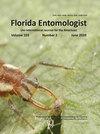草地贪夜蛾(鳞翅目:夜蛾科)雌性能检测到同种雌性释放的性信息素
IF 1.2
4区 农林科学
Q3 ENTOMOLOGY
引用次数: 1
摘要
摘要Frugieperda J.E.Smith(鳞翅目:夜蛾科)雌性发出的性信息素吸引雄性进行交配,但到目前为止,还没有研究是否也吸引了雌雄同体。在这里,报告了S.Frugieperda雌性在飞行隧道实验室生物分析和野外诱捕中对其性信息素的吸引力。在野外捕获的雌性和雄性生殖器官被分离进行分类鉴定,并用环境扫描电子显微镜进行研究,以了解雌性的交配状态。在风洞吸引生物测试中,处女像雄性一样逆风降落在刺激物上,而被杀的雌性虽然前往刺激物,但着陆次数较少。田间捕获昆虫的性别比为1女4男。精子的存在允许使用生殖器分离母性和处女;在整个取样期间,都在陷阱中发现了这两个。这项研究表明,S.Frugiperda雌性自我检测其性信息素,并讨论了其对这些母亲管理战略的影响。摘要Frugieperda J.E.Smith(鳞翅目:夜蛾科)雌性发出的性信息素会吸引雄性进入交配,但目前还没有研究来调查雌性是否被吸引。在这项研究中,有报道称,在飞行隧道和野外陷阱的实验室生物测定中,Frugieperda雌性对其性信息素的吸引力。对野外捕获的雌性和雄性的生殖器官进行了解剖,以进行分类鉴定,并用环境扫描电子显微镜进行了研究,以了解雌性的交配状态。在风洞中的吸引力生物测定中,处女像雄性一样逆风飞行并在刺激物中停留,而交配的雌性虽然朝着刺激物前进,但着陆次数较少。在野外,捕获的昆虫的性别比例为每四只雄性中有一只雌性。交配雌性和处女的生殖器官因生精器的存在而不同。这项研究表明,S.frugiperda的雌性能够自我检测其性信息素,并讨论了其对这些帕洛米拉斯的管理策略的影响。本文章由计算机程序翻译,如有差异,请以英文原文为准。
Spodoptera frugiperda (Lepidoptera: Noctuidae) Females Can Detect the Sex Pheromone Emitted by Conspecific Females
Abstract The sex pheromones emitted by Spodoptera frugiperda J.E. Smith (Lepidoptera: Noctuidae) females attract males for copulation, but no studies to date have investigated if conspecific females also are attracted. Here, the attraction of females of S. frugiperda to their sex pheromone in flight tunnel laboratory bioassays and field trapping is reported. Genitalia of females and males captured in the field were dissected for taxonomic identification and studied with an environmental scanning electron microscope to know the mating status of the females. In wind tunnel attraction bioassays, virgin females flew upwind and landed on the stimulus, likewise the males, whereas mated females, although they headed for the stimulus, showed fewer landings. The sex ratio of captured insects in the field was 1 female to 4 males. The presence of spermatophores allowed the separation of mated and virgin females using the genitalia; both were found in the traps throughout the sampling period. This study demonstrated that S. frugiperda females autodetect their sex pheromone, and its implications on the management strategy for these moths are discussed. Resumen Las feromonas sexuales emitidas por las hembras de Spodoptera frugiperda J. E. Smith (Lepidoptera: Noctuidae) atraen a los machos para la cópula, pero no hay estudios que investiguen si las hembras conespecíficas son atraídas. En este estudio, se informa de la atracción de las hembras de S. frugiperda a su feromona sexual en bioensayos de laboratorio en túnel de vuelo, y trampas de campo. Se disectaron las genitalias de las hembras y los machos capturados en el campo para su identificación taxonómica y también se estudiaron con el microscopio electrónico de barrido ambiental para conocer el estado de apareamiento de las hembras. En los bioensayos de atracción en el túnel de viento, las hembras vírgenes volaron contra el viento y se posaron en el estímulo, al igual que los machos, mientras que las hembras apareadas, aunque se dirigieron al estímulo, mostraron menos aterrizajes. En el campo, la proporción sexual de los insectos capturados fue de una hembra por cada cuatro machos. Las genitalias de las hembras apareadas y vírgenes se distinguieron por la presencia del espermatóforo. Este estudio demuestra que las hembras de S. frugiperda autodetectan su feromona sexual y se discuten sus implicaciones en la estrategia de manejo de estas palomillas.
求助全文
通过发布文献求助,成功后即可免费获取论文全文。
去求助
来源期刊

Florida Entomologist
生物-昆虫学
CiteScore
2.10
自引率
7.10%
发文量
44
审稿时长
3 months
期刊介绍:
Florida Entomologist is the official journal of the Florida Entomological Society. Volumes 1-3 were published under the name The Florida Buggist. The Florida Entomological Society still produces the traditionally printed version of Florida Entomologist, but you can also view, search, or print any article published since June 1917 by accessing online files. Web access is made possible by the Society’s electronic publication project begun in 1993
 求助内容:
求助内容: 应助结果提醒方式:
应助结果提醒方式:


